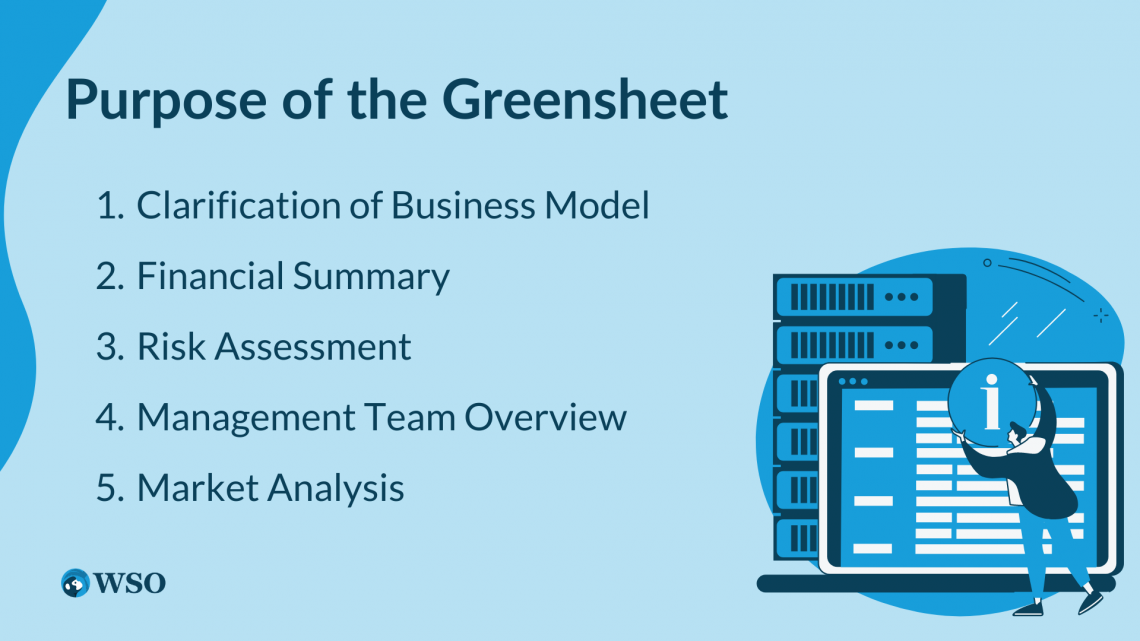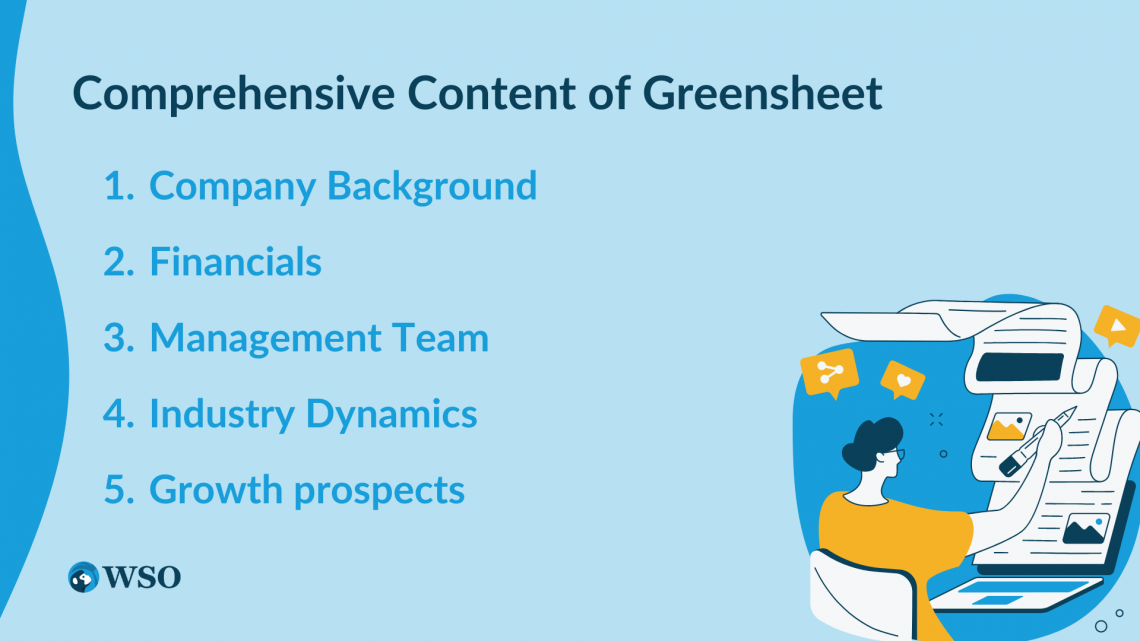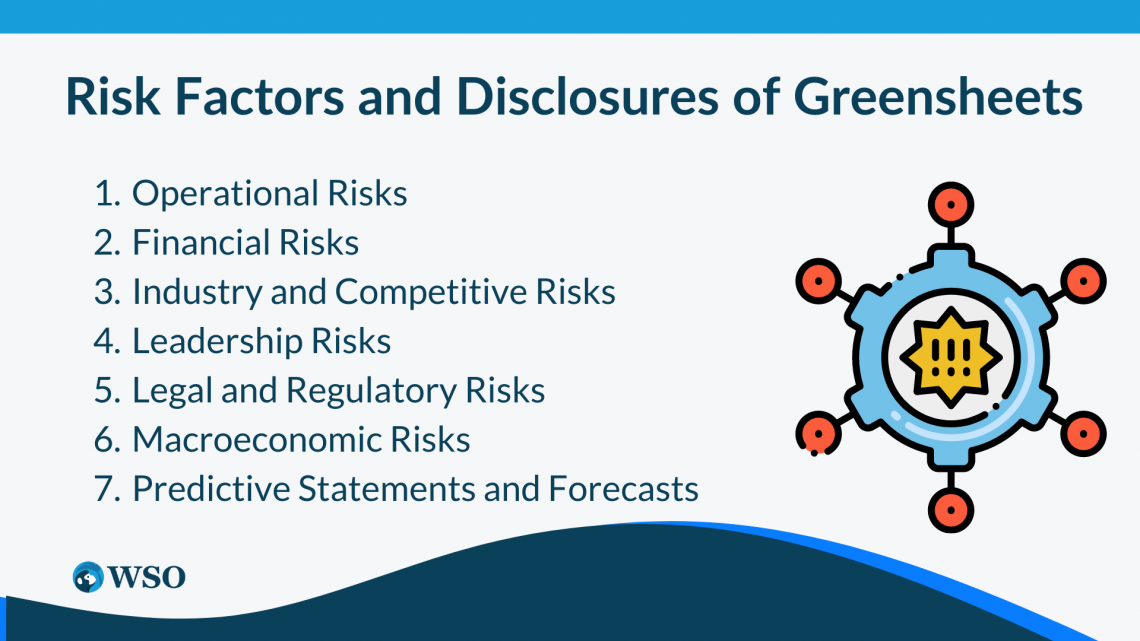Greensheet
A greensheet is a comprehensive document created by an underwriter to outline key aspects of a new issuance or initial public offering (IPO).
A deal sheet, also referred to as a greensheet, is a carefully constructed document by an underwriter detailing the essential components of a new issuance or an initial public offering (IPO).

This in-house resource functions as a marketing tool aimed at generating excitement among prospective institutional investors and brokers.
By offering an all-encompassing overview of the IPO's crucial features, the deal sheet empowers underwriters to proficiently convey the advantages of the investment proposition and secure backing from the intended recipients.
The deal sheet typically includes information such as the company's business plan and financial statements, the size and price of the offering, the underwriting fees, and the target audience for the offering. It may also provide details about the underwriting syndicate and the roles and responsibilities of each member.
The process of creating a deal sheet involves collaboration among the underwriting team, the issuer, and other parties involved in the IPO. The document is typically revised and updated throughout the underwriting process to reflect any changes in the offering or market conditions.
- A deal sheet, also known as a greensheet, is a document crafted by underwriters that encompasses crucial aspects of an IPO intending to spark interest among potential institutional investors and brokers.
- The primary objective of a deal sheet is to function as a promotional instrument for the success of the IPO.
- The deal sheet offers an extensive IPO analysis, covering aspects such as the company's background, financial performance, management team, industry landscape, growth opportunities, and unique competitive edge.
- Deal sheets tackle potential risks and provide relevant disclosures associated with the IPO, ensuring a transparent understanding for prospective investors.
- Key details like the suggested price range, valuation, deal size, P/E ratio, and underwriting information enable investors to make well-informed choices regarding their participation in the offering.
Purpose of the Greensheet
This internal-use document functions as a promotional tool to generate excitement among prospective institutional investors and brokers. It seeks to facilitate a deeper understanding of the company's prospects, financials, and overall market position.

By providing in-depth information and analysis, the green sheet enables investors to make well-informed decisions, enhancing the chances of a favorable reception and robust performance for the IPO.
This comprehensive resource, therefore, plays a pivotal role in the overall promotion and eventual success of the initial public offering.
1. Clarification of Business Model
Greensheets help clarify the company's business model and strategy, breaking down the complexities for potential investors.
It includes information such as how the company generates revenue, its cost structure, key customer segments, and competitive differentiators.
2. Financial Summary
A comprehensive financial summary is provided, including past performance, projected revenues, and earnings. This allows investors to evaluate the company's financial health and growth potential.
3. Risk Assessment
The document presents an analysis of potential risks associated with investing in the company. This includes market risks, regulatory risks, competitive threats, and potential challenges to the company's business model.

It promotes transparency, ensuring investors are fully aware of the potential pitfalls before they invest.
4. Management Team Overview
Information about the company's management team, including their backgrounds, relevant experience, and track records, is provided. This allows investors to assess the quality and competence of those leading the company.
5. Market Analysis
The Greensheet provides an analysis of the market conditions, including the size of the market, growth trends, and competitive landscape. This analysis can help investors understand the broader context in which the company operates.
Comprehensive Content of Greensheet
The deal sheet delivers a comprehensive analysis of the IPO's crucial aspects, giving potential investors a holistic view of the investment proposition. These facets encompass:

1. Company Background
The deal sheet emphasizes the company's background, vision, mission, and central business activities, equipping investors with a robust grasp of the organization's character, strengths, and long-term aspirations.
2. Financials
The document delves into the company's financial results, showcasing essential figures such as revenues, net profits, EBITDA, and cash flows. This data enables investors to scrutinize the company's financial stability, profitability, and growth potential.
3. Management Team
The deal sheet offers an in-depth look at the company's executive team, including their experiences, credentials, and achievements. This information aids investors in assessing the team's capacity to implement the company's strategies and propel its success.
4. Industry Dynamics
The document investigates the company's industry, describing market dimensions, competitive dynamics, trends, obstacles, and opportunities.
This insight allows potential investors to comprehend the company's operating environment and evaluate the investment's feasibility, considering industry factors.
5. Growth prospects
The deal sheet showcases the company's growth plans, including new product introductions, geographic outreach, market penetration, and mergers or acquisitions.

The document highlights the company's competitive strengths, accentuating aspects such as proprietary innovations, robust brand recognition, operational effectiveness, or strategic alliances that distinguish the company from its rivals and support its sustained success.
By furnishing this all-encompassing content, the deal sheet enables potential investors to examine the investment opportunity meticulously, make well-informed choices, and fully comprehend the company's outlook and potential hazards.
This degree of detail ultimately leads to a more transparent and streamlined IPO process.
Risk Factors and Disclosures of Greensheets
Greensheets not only offer an in-depth overview of the investment proposition but also present potential risks and pertinent disclosures related to the IPO.

This approach guarantees potential investors a clear insight into the challenges they could encounter. Some of the primary risk factors and disclosures featured in greensheets are:
1. Operational Risks
These risks are associated with the company's activities, encompassing aspects such as reliance on key clients, suppliers, or a restricted product portfolio.
Operational risks might also include regulatory shifts, intellectual property conflicts, or possible interruptions in the supply chain.
2. Financial Risks
Financial risks cover elements that could adversely affect the company's financial results or stability, including substantial debt, variable exchange rates, or fluctuating interest rates.
Financial risks might impact the company's capacity to generate revenue, fulfill financial commitments, or sustain its growth path.
3. Industry and Competitive Risks
Industry and competitive risks allude to the difficulties the company might face in its sector or market, comprising fierce competition, evolving customer preferences, or introducing new technologies that might render its offerings obsolete.
4. Leadership Risks
These risks are connected to the company's management team, emphasizing potential issues like the departure of crucial executives, insufficient experience in a specific market, or inadequate succession strategies.
5. Legal and Regulatory Risks
Legal and regulatory risks entail potential compliance concerns, ongoing or prospective lawsuits, or regulatory examinations that could influence the company's operations or reputation.
6. Macroeconomic Risks
These risks involve broader economic factors that could impact the company's performance, such as economic recessions, political unrest, or international events that might disrupt markets or supply networks.
7. Predictive Statements and Forecasts
Greensheets frequently include forecasts and predictive statements regarding the company's future performance.

By incorporating risk factors and disclosures in greensheets, underwriters ascertain that potential investors understand the investment opportunity comprehensively.
This degree of transparency promotes well-informed decision-making and aids in averting potential misinterpretations or disagreements later on.
Pricing and Valuation of Greensheets
Deal sheets often feature details about the proposed price range, valuation, and deal size of the IPO, enabling investors to examine the investment's potential returns and attractiveness.

These elements are vital for investors to make informed decisions:
1. Expected Price Range
The deal sheet usually presents the projected price range for each share in the IPO, giving investors a preliminary idea of the expense associated with participating in the offering. The final price might vary depending on market conditions and investor demand.
2. Valuation Significance
Assessment of worth is crucial in the context of an initial public offering, given that it signifies the organization's anticipated worth derived from aspects like revenue, future expansion possibilities, and sector standards.
Deal sheets commonly showcase an approximate valuation or valuation range, helping investors assess the company's market value and determine if the investment aligns with their risk and return preferences.
3. Deal Size
The deal size signifies the total capital the company aims to raise through the IPO. This amount, featured in the deal sheet, assists investors in comprehending the scope of the offering and the company's fundraising goals.
Furthermore, it offers insights into the possible dilution of existing shares and its effects on the company's capital structure.
4. Price-to-Earnings Proportion
The transaction summary could additionally showcase the Price-to-Earnings (P/E) Proportion, an evaluation indicator that contrasts the cost for each share with the organization's earnings for each share (EPS).
The Price-to-Earnings Proportion ratio helps investors evaluate the company's relative value compared to its competitors and the overall market.
5. Underwriting Information
The document might also include details about the underwriting process, such as lead underwriters, the underwriting syndicate, and any underwriting discounts or commissions.
This information enables investors to evaluate the reliability of the IPO process and the parties involved.
By including pricing and valuation information in the deal sheet, investors can more effectively assess the IPO's appeal, its potential returns, and any related risks.
This thorough information supports the decision-making process, ensuring that investors make well-informed decisions about their involvement in the offering.
Comparing a Greensheet and Prospectus: Key Differences and Similarities
A greensheet and a prospectus are distinct yet interrelated documents utilized in the realm of financial transactions and securities offerings. However, their functions, target audiences, and regulatory requirements differ significantly.

1. Prospectus
Conversely, a prospectus is a publicly accessible legal document that companies must provide when they offer securities for sale to the public. It includes comprehensive data about the company, its management team, and the securities being issued.
This data includes financial reports, the company's business strategy, potential risks, and details regarding the proposed use of funds raised from the offering.
The purpose of a prospectus is to deliver potential investors with all the essential information needed to make an informed investment decision. It is a document regulated by financial authorities to ensure transparency and protect the interests of investors.
2. Comparison
Though both documents offer intricate details about a security offering, the primary distinction is the audience they cater to. The greensheet is designed for internal use by the sales team of the underwriting firm, whereas the prospectus is a public document aimed at prospective investors.
Another significant difference is their legal status. While the issuance of a prospectus is legally mandated and must comply with specified regulatory standards, greensheets are not subject to the same regulations.
The content of a greensheet should never contradict the information presented in the prospectus.
In conclusion, both the greensheet and the prospectus play critical roles during an IPO or secondary market offering.
The greensheet aids in promoting the securities, while the prospectus serves as a crucial resource for investor transparency and informed decision-making.









or Want to Sign up with your social account?